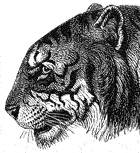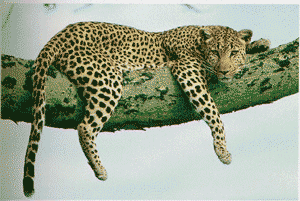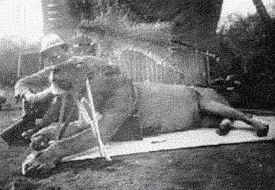The Champawat Tigress
 From 1900 to 1907, a tiger went on the worst killing spree ever recorded, attacking and killing 436 people. It started its reign of terror in western Nepal in 1900, where it killed 200 villagers. After it was driven out of Nepal by a massive beat by thousands of villagers, it settled in Champawat, India, where it killed another 236 people. The tigress was eventually killed by the famous game hunter, Jim Corbett.
From 1900 to 1907, a tiger went on the worst killing spree ever recorded, attacking and killing 436 people. It started its reign of terror in western Nepal in 1900, where it killed 200 villagers. After it was driven out of Nepal by a massive beat by thousands of villagers, it settled in Champawat, India, where it killed another 236 people. The tigress was eventually killed by the famous game hunter, Jim Corbett.
Examination of the tigress showed that she had extensive damage to her teeth, which Corbett speculated would have prevented her from hunting her natural prey.
Corbett reports that on his arrival at the site of the tigress' last victim, a 16-year-old girl out gathering firewood, he found the village in a state of abject terror, the streets deserted. The villagers had locked themselves in their huts and no one had ventured out in a week, still terrified by the roars of the tigress who continued to prowl around the village. Corbett tracked the tiger from the site of its last attack, following the tracks through blackthorn bushes, still draped with "long strands of the girl's raven-black hair" (see Man-Eaters of Kumaon (Oxford India Paperbacks) by Jim Corbett, page 17). Here he found a part of the victim's leg: "I have not seen anything as pitiful as that young comely leg bitten off a little below the knee as clean as though severed by the stroke of an axe," Corbett wrote. He was alerted to the presence of the tigress by loose dirt rolling down a steep embankment in front of him. He then shot and killed the tigress, ending her deadly reign. Today, a stone plaque marks the village and gives details of how Corbett tracked the tigress down and finally killed her.
Jim Corbett wrote a number of excellent books regarding his adventures hunting man-eaters. These books are available at Amazon.com
Panar Man-eater
 "If the leopard were as big as the lion, it would be ten times more
dangerous. Once it becomes accustomed to human flesh, the leopard
exhibits an almost diabolical cunning." John Taylor, professional big-game hunter.
"If the leopard were as big as the lion, it would be ten times more
dangerous. Once it becomes accustomed to human flesh, the leopard
exhibits an almost diabolical cunning." John Taylor, professional big-game hunter.
Leopards also can become man-eaters, and when they do so, they can prove even more lethal than tigers. The deadliest leopard of all was the Panar man-eater, which operated in Panar province, a remote area in central Kumaon in northern India. This big male leopard is reputed to have killed 400 people. The leopard was killed by Jim Corbett in 1942. Jim Corbett noted that tigers were typically responsible for only daytime human kills, while those at night were normally the result of a leopard attack. Also, tigers hunt from cover, and will not usually enter a settlement or even a tent to attack victims. Leopards, however, will roam freely through a settlement and even tear down a door to get at a victim.
Leopard of Rudraprayag
Between 1918 and 1926 in Rudraprayag, India, some 125 people were killed by the "Leopard of Rudraprayag". It stalked and killed pilgrims en route to Hindu shrines in northern India. The leopard eluded a succession of traps and bullets, but was finally killed by Jim Corbett. It was found to be a very old leopard and may have originally come from a menagerie. In the same region in the previous century, between 1857 and 1860, another leopard known as the Kahani man-eater
is said to have killed over 200 people.
The Lions of Njombe
In 1932, in Tanzania near the southern town of Njombe, a pride of 15 lions began a spate of human killings. It took 15 years to track down and kill all 15 lions from the pride, and by this time around 1,000 people had been killed. An interesting feature of these attacks was that there was no obvious reason why the pride began their attacks on humans. The cats were healthy, and there was plenty of alternative prey in the Njombe region.
Tsavo Lions
 “One dark night the familiar terroricken cries and screams awoke the camps, and we knew that the ‘demons’ had returned and had commenced a new list of victims. The alarm was at once given, and sticks, stones, and firebrands were hurled in the direction of the intruder. All was of no avail, however, for the lion burst into the midst of the terrified group, seized an unfortunate wretch amid the cries and shrieks of his companions, and dragged him off through the thick thorn fence. He was joined outside by the second lion, and so daring had the two brutes become that they did not trouble to carry their victim any further away, but devoured him within thirty yards of the tent where he had been seized.”
“One dark night the familiar terroricken cries and screams awoke the camps, and we knew that the ‘demons’ had returned and had commenced a new list of victims. The alarm was at once given, and sticks, stones, and firebrands were hurled in the direction of the intruder. All was of no avail, however, for the lion burst into the midst of the terrified group, seized an unfortunate wretch amid the cries and shrieks of his companions, and dragged him off through the thick thorn fence. He was joined outside by the second lion, and so daring had the two brutes become that they did not trouble to carry their victim any further away, but devoured him within thirty yards of the tent where he had been seized.”
~ Source: Lieutenant-Colonel J. H. Patterson, The Man-Eaters of Tsavo (London: D. S. O. MacMillan and Co., Ltd., 1919), page 64.
In March 1898, two large male lions began to attack railway workers at the Tsavo River in East Africa where a railway bridge was being built by the British. Over the next 9 months, the lions killed and ate nearly 140 people, causing hundreds of workers to flee Tsavo, and halting construction on the bridge. The Chief Engineer, Lt. Col. John Henry Patterson (1865–1947), had to eliminate the lions and their threat. He eventually shot and killed the first lion on December 9, 1898. Three weeks later, he brought down the second. The first killed lion measured nine feet and eight inches from nose to tip of tail. Although male, both lions were maneless, a common trait for lions in the Tsavo region.
Patterson later wrote a book on his experiences at Tsavo. It is available at Amazon.com . The thrilling 1996 movie, The Ghost and the Darkness (available at Amazon.com
. The thrilling 1996 movie, The Ghost and the Darkness (available at Amazon.com ), was also loosely based on Patterson’s adventures in Tsavo.
), was also loosely based on Patterson’s adventures in Tsavo.
